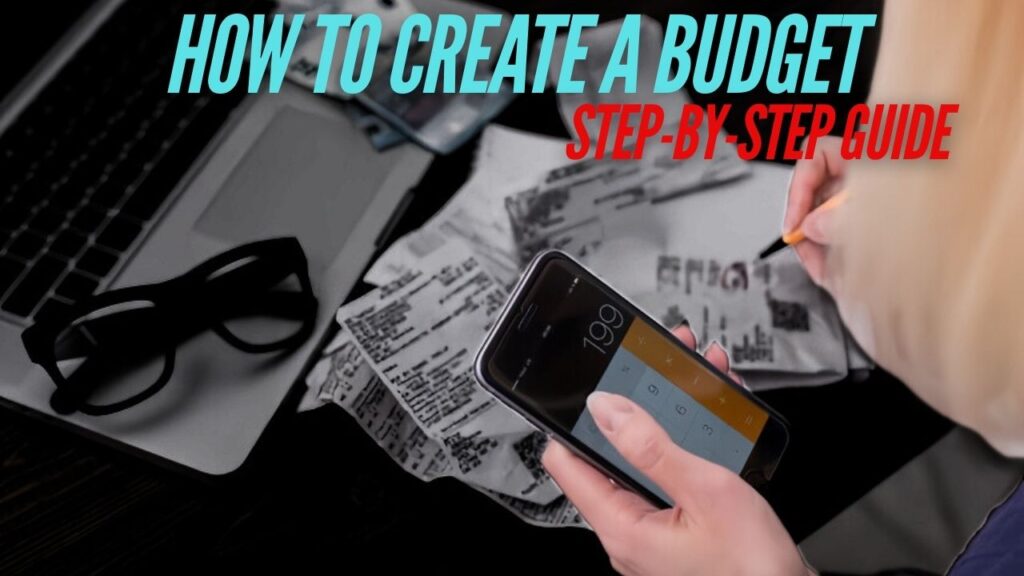
One of the best methods to manage your money, reduce anxiety, and make future plans is to create a budget. A detailed budget might help you in achieving your financial goals, whether your aim is to grow your savings, lower your debt, or just enhance your spending efficiency. In this blog, we’ll guide you step-by-step through the process of making a budget that’s right for you.

1. Set specific financial goals
It is crucial to understand why you are planning a budget before getting into the figures. Are you putting money down for a down payment on a home? Repaying your education loans? Or perhaps you would like to save money for emergencies? Setting financial objectives will help you stay on track with your budget by giving it guidance and motivation.
Short-term goals: A few examples of short-term objectives might be saving money for a trip or paying off credit card debt.
Long-term goals: Long-term financial ambitions include things like saving for retirement, purchasing a home, and covering a child’s schooling.
2. Monitor Your Income
As you move on with your budget, you need to be aware of your specific income. If you receive a continuous paycheck, this is usually easy. However, if you work for yourself or have multiple sources of income, you will need to figure out your average monthly revenue.
- List all of your revenue sources, including investment returns, side jobs, freelancing, and your pay.
- Be careful to figure out your net income—that is, your income after taxes and other deductions.
Read More : 9 Most Dangerous Risks of AI
3. Make a List of Every Expense
Creating a detailed budget is the next step when you have a solid knowledge of your revenue. Both fixed and variable costs are included in this.
- Fixed expenses include things like electricity, insurance premiums, loan payments, rent or a mortgage, and other regular, predictable costs.
- Expenses that vary from month to month include food, eating out, entertainment, and personal care.

4. Arrange Your Expenses
Once you’ve compiled a list of costs, it’s essential to divide them into necessities and desires.
- Needs: Basic necessities such as utilities, groceries, housing, cars, and medical care.
- Wants: Extras like shopping, entertainment, dining out, and streaming services.
- This phase helps you to figure out where you may make needed reductions and what expenses are necessary.
5. Make a budget plan
Creating your budget is the next thing to do after you’ve made a list of your income and expenses. As a general rule, apply the following formula:
- We should allocate 50% of your revenue to needs.
- Set 30% for desires.
- 20% should be dedicated to repaying debts or savings.
- This is known as the 50/30/20 rule, but you can change the ratios depending on your needs and financial goals.
6. Track and Modify Your Expenses
You still have work to do after your budget is in place. It will be important for you to closely monitor how you spend money and make any necessary changes.
- Make sure you’re following your strategy by reviewing your budget once a week or once a month.
- Look for methods to reduce your spending if you find that you are overspending in some areas. Consider cutting
- back on takeout or canceling subscriptions that aren’t being used.
- If you want to keep yourself on track, plan on using budgeting apps like PocketGuard, YNAB (You Need a Budget), or Mint.
7. Make an Irregular Expense Plan
Your budget may be seriously affected by unanticipated expenses such as auto repairs or medical expenses. Set a monthly budget for unexpected expenses like these to avoid being caught off guard. This may be included in your emergency fund or savings.
8. Create an Emergency Fund
A financial reserve such as an emergency fund can help you pay for unanticipated expenses without incurring debt. Your emergency fund should ideally contain three to six months’ worth of living expenses.
Even if you have only $10 a week to start, start small and build it over time.

Read More : 10 Strategies How Chatbots Can Increase ROI on Email Marketing
9. Use Strategy to Pay Off Debt
Make it a top priority in your budget to pay off whatever debt you may have. Start by focusing on bills with high interest rates, like credit card debt, as they may build up rapidly and end up costing you more money over time.
You might apply the debt avalanche strategy, which involves paying off the loans with the highest interest rates first, or the debt snowball method, which involves paying off the smallest bills first for a psychological boost.
10. Regularly review and revisit your budget
Your budget should adapt to changes in life. Review it if a big life event takes place, such as getting a raise, moving, or having a child, or at least every few months. Make necessary adjustments to your budget to account for your shifting goals toward money, as well as your shifting income and expenses.
Conclusion
It is not necessary to have a difficult budget to create and follow. You’ll take charge of your money and be more prepared to handle situations that arise if you follow these steps. Being aware of your spending patterns and maintaining consistency are essential. You can achieve financial success and stability by creating a sound budget.









